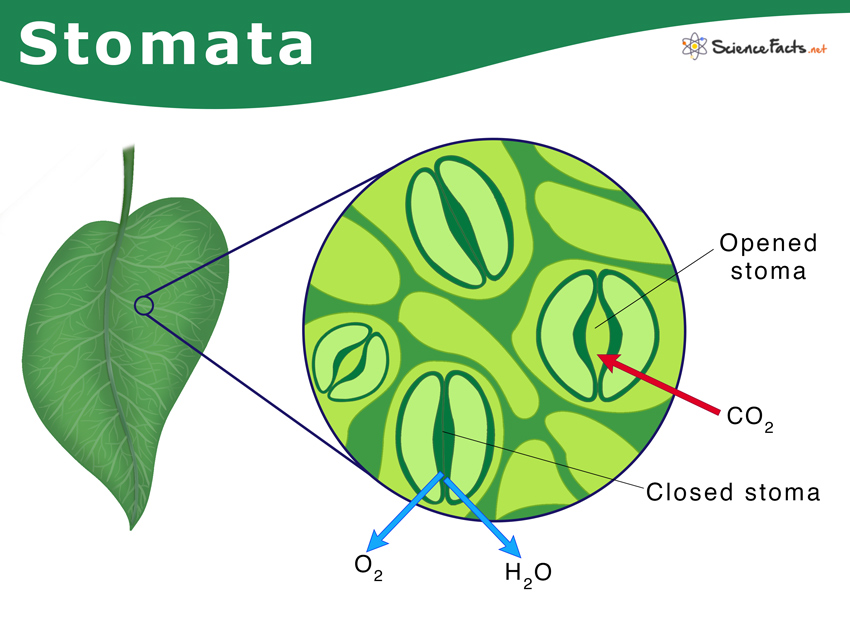Just like animals breathe, plants do so with the help of stomata. Under the microscope, they appear dense or dark. Stomata also help to protect a plant from dehydration caused due to excessive loss of water.
Stoma vs. Stomata
Structure of Stomata
Stomatal Density
Types of Stomata
Factors Affecting Opening and Closing of Stomata
How Do they Open and Close
Functions and Uses
It is made of two guard cells – a pair of specialized, kidney-shaped epidermal cells. The epidermal cells are located in the epidermal tissue, border the guard cells. They are also called accessory cells or subsidiary cells. The guard cells are joined together but are free to separate and form a pore. The stoma opens to the interior into a sub-stomatal cavity that remains connected to the intercellular spaces. The table below shows examples of stomatal density on the upper and lower surfaces of leaves of some common dicot and monocot plants:
Based on the Structure and Arrangement of the Subsidiary Cells
The arrangement of subsidiary cells is found to be different in dicot and monocot plants. Accordingly, stomata are classified into: Stoma Found in Dicots
Actinocytic (star-celled): Stoma with guard cells surrounded by at least five subsidiary cells, forming a star-shaped circle. Anisocytic (unequal-celled): Stoma with guard cells between two large subsidiary cells and a smaller one.Anomocytic (irregular-celled): Stoma with guard cells surrounded by subsidiary cells of equal size, shape, and arrangement. Diacytic (cross-celled): Stoma with guard cells surrounded by two subsidiary cells perpendicular to each stoma.Hemiparacytic (half-parallel celled): Stoma with guard cells that are bordered by one subsidiary cell.Paracytic (parallel celled): Stoma with one or more subsidiary cells parallel to the guard cells’ opening.
Stoma Found in Monocots
Gramineous (grass-like): Stoma with two guard cells surrounded by two lens-shaped subsidiary cells.Hexacytic (six-celled): Stoma with six subsidiary cells around both guard cells.Tetracytic (four-celled): Stoma with four subsidiary cells, one on either end of the opening or one next to each guard cell.
Based on Cell Development
These are of three types:
Mesogynous Type: Here, both guard cells and subsidiary cells are developed from one mother cell.Perigynous Type: Here, guard cells are formed from the primary mother cell, while subsidiary cells from accessory mother cells.Mesoperigynous Type: Here, guard cells and one subsidiary cell is formed from the mother cell, while other subsidiary cells develop independently.
Based on Arrangement and Distribution of Stomata
Apple or Mulberry Type: Found only on the lower surface of leaves.Potato Type: Found more on the lower surface and less on its upper surface.Oat Type: Found equally distributed on both leaf surfaces.Water Lily Type: Found only on the upper surface of the leaf.Potamogeton Type: They are absent, or if present, they are vestigial.
When the Stomata Remain Closed When evaporation from the aerial parts is high, stomata close to prevent plant dehydration under hot and dry conditions. The guard cells actively pump potassium ions out of the cell, causing a difference in solute concentration. This ion efflux pushes the water out of the cell from an area of low solute concentration (inside the guard cell) to an area of high solute concentration (surrounding cells). At this stage, the guard cells become flaccid, making it look like the letter ‘I’. Also, during the night, in the absence of transpiration, the stomata remain closed. When the Stomata Remains Open For stomata to open during the daytime, potassium ions are actively transported inside the guard cell, increasing its concentration. This ion influx drives the entry of water inside the cell by osmosis, increasing cell turgidity and opening of stomata. At this stage, the two inflated guard cells look like the letter ‘O’. Gas Exchange: Acts as an entryway for carbon dioxide that acts as one of the raw materials for photosynthesis and also the exit point of oxygen that is a byproduct. Regulating Transpiration: Stomata play an essential role in transpiration by changing their size based on environmental signals. This change is done with guard cells’ help, which expands and contracts to carry out the process. Thus, the entire process from the absorption of water and minerals through roots, their distribution within the plant body, and the final water release depend on the stomatal activity.
